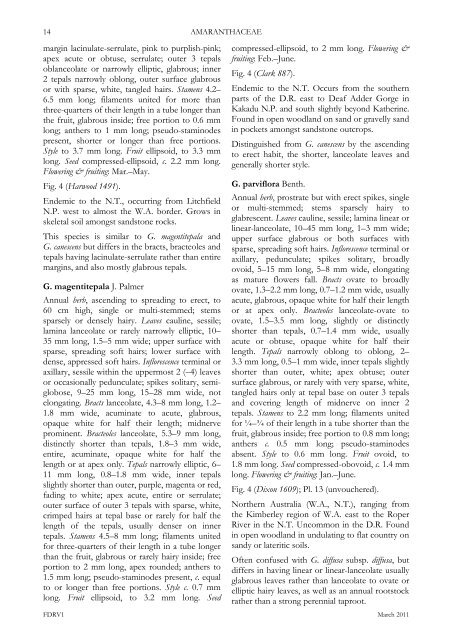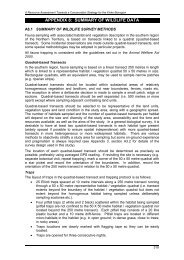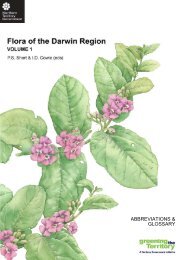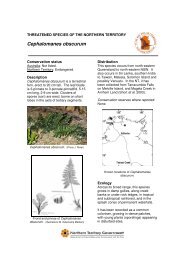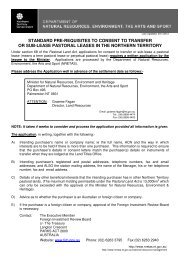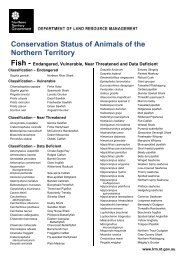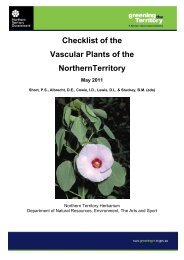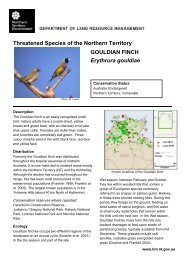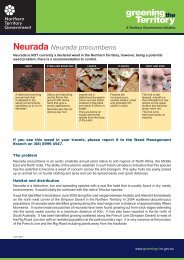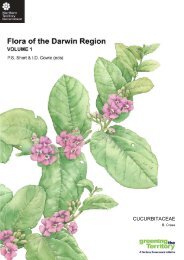AMARANTHACEAE - Department of Land Resource Management ...
AMARANTHACEAE - Department of Land Resource Management ...
AMARANTHACEAE - Department of Land Resource Management ...
You also want an ePaper? Increase the reach of your titles
YUMPU automatically turns print PDFs into web optimized ePapers that Google loves.
14<br />
margin lacinulate-serrulate, pink to purplish-pink;<br />
apex acute or obtuse, serrulate; outer 3 tepals<br />
oblanceolate or narrowly elliptic, glabrous; inner<br />
2 tepals narrowly oblong, outer surface glabrous<br />
or with sparse, white, tangled hairs. Stamens 4.2–<br />
6.5 mm long; filaments united for more than<br />
three-quarters <strong>of</strong> their length in a tube longer than<br />
the fruit, glabrous inside; free portion to 0.6 mm<br />
long; anthers to 1 mm long; pseudo-staminodes<br />
present, shorter or longer than free portions.<br />
Style to 3.7 mm long. Fruit ellipsoid, to 3.3 mm<br />
long. Seed compressed-ellipsoid, c. 2.2 mm long.<br />
Flowering & fruiting: Mar.–May.<br />
Fig. 4 (Harwood 1491).<br />
Endemic to the N.T., occurring from Litchfield<br />
N.P. west to almost the W.A. border. Grows in<br />
skeletal soil amongst sandstone rocks.<br />
This species is similar to G. magentitepala and<br />
G. canescens but differs in the bracts, bracteoles and<br />
tepals having lacinulate-serrulate rather than entire<br />
margins, and also mostly glabrous tepals.<br />
G. magentitepala J. Palmer<br />
Annual herb, ascending to spreading to erect, to<br />
60 cm high, single or multi-stemmed; stems<br />
sparsely or densely hairy. Leaves cauline, sessile;<br />
lamina lanceolate or rarely narrowly elliptic, 10–<br />
35 mm long, 1.5–5 mm wide; upper surface with<br />
sparse, spreading s<strong>of</strong>t hairs; lower surface with<br />
dense, appressed s<strong>of</strong>t hairs. Inflorescence terminal or<br />
axillary, sessile within the uppermost 2 (–4) leaves<br />
or occasionally pedunculate; spikes solitary, semiglobose,<br />
9–25 mm long, 15–28 mm wide, not<br />
elongating. Bracts lanceolate, 4.3–8 mm long, 1.2–<br />
1.8 mm wide, acuminate to acute, glabrous,<br />
opaque white for half their length; midnerve<br />
prominent. Bracteoles lanceolate, 5.3–9 mm long,<br />
distinctly shorter than tepals, 1.8–3 mm wide,<br />
entire, acuminate, opaque white for half the<br />
length or at apex only. Tepals narrowly elliptic, 6–<br />
11 mm long, 0.8–1.8 mm wide, inner tepals<br />
slightly shorter than outer, purple, magenta or red,<br />
fading to white; apex acute, entire or serrulate;<br />
outer surface <strong>of</strong> outer 3 tepals with sparse, white,<br />
crimped hairs at tepal base or rarely for half the<br />
length <strong>of</strong> the tepals, usually denser on inner<br />
tepals. Stamens 4.5–8 mm long; filaments united<br />
for three-quarters <strong>of</strong> their length in a tube longer<br />
than the fruit, glabrous or rarely hairy inside; free<br />
portion to 2 mm long, apex rounded; anthers to<br />
1.5 mm long; pseudo-staminodes present, c. equal<br />
to or longer than free portions. Style c. 0.7 mm<br />
long. Fruit ellipsoid, to 3.2 mm long. Seed<br />
<strong>AMARANTHACEAE</strong><br />
compressed-ellipsoid, to 2 mm long. Flowering &<br />
fruiting: Feb.–June.<br />
Fig. 4 (Clark 887).<br />
Endemic to the N.T. Occurs from the southern<br />
parts <strong>of</strong> the D.R. east to Deaf Adder Gorge in<br />
Kakadu N.P. and south slightly beyond Katherine.<br />
Found in open woodland on sand or gravelly sand<br />
in pockets amongst sandstone outcrops.<br />
Distinguished from G. canescens by the ascending<br />
to erect habit, the shorter, lanceolate leaves and<br />
generally shorter style.<br />
G. parviflora Benth.<br />
Annual herb, prostrate but with erect spikes, single<br />
or multi-stemmed; stems sparsely hairy to<br />
glabrescent. Leaves cauline, sessile; lamina linear or<br />
linear-lanceolate, 10–45 mm long, 1–3 mm wide;<br />
upper surface glabrous or both surfaces with<br />
sparse, spreading s<strong>of</strong>t hairs. Inflorescence terminal or<br />
axillary, pedunculate; spikes solitary, broadly<br />
ovoid, 5–15 mm long, 5–8 mm wide, elongating<br />
as mature flowers fall. Bracts ovate to broadly<br />
ovate, 1.3–2.2 mm long, 0.7–1.2 mm wide, usually<br />
acute, glabrous, opaque white for half their length<br />
or at apex only. Bracteoles lanceolate-ovate to<br />
ovate, 1.5–3.5 mm long, slightly or distinctly<br />
shorter than tepals, 0.7–1.4 mm wide, usually<br />
acute or obtuse, opaque white for half their<br />
length. Tepals narrowly oblong to oblong, 2–<br />
3.3 mm long, 0.5–1 mm wide, inner tepals slightly<br />
shorter than outer, white; apex obtuse; outer<br />
surface glabrous, or rarely with very sparse, white,<br />
tangled hairs only at tepal base on outer 3 tepals<br />
and covering length <strong>of</strong> midnerve on inner 2<br />
tepals. Stamens to 2.2 mm long; filaments united<br />
for ¼–¾ <strong>of</strong> their length in a tube shorter than the<br />
fruit, glabrous inside; free portion to 0.8 mm long;<br />
anthers c. 0.5 mm long; pseudo-staminodes<br />
absent. Style to 0.6 mm long. Fruit ovoid, to<br />
1.8 mm long. Seed compressed-obovoid, c. 1.4 mm<br />
long. Flowering & fruiting: Jan.–June.<br />
Fig. 4 (Dixon 1609); Pl. 13 (unvouchered).<br />
Northern Australia (W.A., N.T.), ranging from<br />
the Kimberley region <strong>of</strong> W.A. east to the Roper<br />
River in the N.T. Uncommon in the D.R. Found<br />
in open woodland in undulating to flat country on<br />
sandy or lateritic soils.<br />
Often confused with G. diffusa subsp. diffusa, but<br />
differs in having linear or linear-lanceolate usually<br />
glabrous leaves rather than lanceolate to ovate or<br />
elliptic hairy leaves, as well as an annual rootstock<br />
rather than a strong perennial taproot.<br />
FDRV1 March 2011


